Hermetia illucens
Hermetia illucens, the black soldier fly, is a common and widespread fly of the family Stratiomyidae.
| Hermetia illucens | |
|---|---|
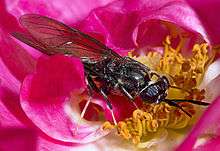 | |
| Hermetia illucens on a rose | |
| Scientific classification | |
| Kingdom: | Animalia |
| Phylum: | Arthropoda |
| Class: | Insecta |
| Order: | Diptera |
| Family: | Stratiomyidae |
| Genus: | Hermetia |
| Species: | H. illucens |
| Binomial name | |
| Hermetia illucens | |
| Synonyms[1] | |
|
List
| |
Distribution
This species is native to the Neotropical realm, but in recent decades has spread across all continents, becoming virtually cosmopolitan. It is present in most of the United States and Europe, including the Iberian Peninsula, southern France, Italy, Croatia, Malta, the Canary Islands, and Switzerland, on the Black Sea coast of Russia in the Krasnodar Territory.[2] It can also be found in the Afrotropical realm, the Australasian realm, the east Palaearctic realm, the Nearctic realm, North Africa, Southern Africa, and the Indomalayan realm.[3][4]
Description
The adults of H. illucens measure about 16 millimetres (5⁄8 in) long.[5] These medium-sized flies have a predominantly black body, with metallic reflections ranging from blue to green on the thorax and sometimes with a reddish end of the abdomen. The second abdominal tergite has translucent areas, from which the specific Latin epithet derives. The head is wide, with very developed eyes. The antennae are about twice the length of the head. The legs are black with whitish tarsi. The wings are membranous; in the resting time, they are folded horizontally on the abdomen and overlapped.[6]
H. illucens is a mimic fly, very close in size, color, and appearance to the organ pipe mud dauber wasp and its relatives. The mimicry of this particular kind of wasp is especially enhanced in that the fly's antennae are elongated and wasp-like, the fly's hind tarsi are pale, as are the wasp's, and the fly has two small transparent "windows" in the basal abdominal segments that make the fly appear to have a narrow "wasp waist".[6] Black soldier fly larvae can be differentiated from blowfly or housefly larvae by a thin gray-black stripe on their posterior ends.
Lifecycle
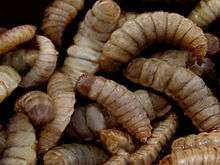
An adult female lays between 206 and 639 eggs at a time.[7] These eggs are typically deposited in crevices or on surfaces above or adjacent to decaying matter such as manure or compost and hatch in about 4 days.[8] Freshly emerged larvae are 1.0 millimetre (0.04 in), being able to reach a length of 2.5 millimetres (0.1 in) and weight of 0.10 to 0.22 grams (1.5 to 3.4 gr) by the end of larval stage.[6] The larval stage lasts from 18 to 36 days, depending on the food substrates provided to the larvae,[7][9] of which the postfeeding (prepupal) stage lasts around 7 days.[10] The length of larval stage can be delayed by months due to low temperature or lack of food.[8] The pupal stage lasts from 1 to 2 weeks.[10][11] Adults can live typically 47 to 73 days when provided with water and food, such as sugar in captivity or nectar in the wild,[12][13] or survive for about 8 to 10 days on fat reserves gathered during larval stage when water is provided.[7]


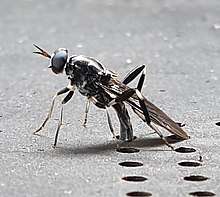
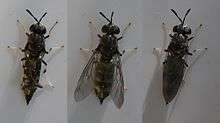
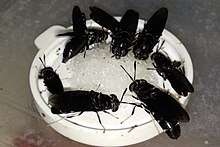
Human relevance and use
The larvae and adults are considered neither pests nor vectors. Instead, black soldier fly larvae play a similar role to that of redworms as essential decomposers in breaking down organic substrates and returning nutrients to the soil. The larvae have voracious appetites and can be used for composting household food scraps and agricultural waste products.
Additionally, black soldier fly larvae (BSFL) are an alternative source of protein for aquaculture, animal feed, pet food and human nutrition.[14]
The larvae are produced and processed in industrial-scale insect factories globally by biotechnology companies such as AgriProtein, InnovaFeed and Protix, the latter operating the world's largest insect factory in the Netherlands.[15]
As decomposers / in composting
Black soldier fly larvae (BSFL) are used to compost waste or convert the waste into animal feed. Fly larvae are among the most efficient animals at converting feed into biomass.
When the larvae have completed their larval development through six instars, they enter a stage called the "prepupa" wherein they cease to eat and empty their guts, their mouth parts change to an appendage that aids climbing, and they seek a humid, sheltered area to pupate. This prepupal migration instinct is used by grub composting bins to self-harvest the mature larvae. These containers have ramps or holes on the sides to allow the prepupae to climb out of the composter and drop into a collection area.The wastes include fresh manure and food wastes of both animal and vegetable origin.
Larvae are beneficial in these ways:
- Their large size relative to houseflies and blowflies allows them to prevent houseflies and blowflies from laying eggs in decaying matter by consuming larvae of other species. This matters because compost systems inhabited by houseflies and blowflies carry a much greater stench than systems inhabited by BSFL, making H. illucens a more human-friendly way to minimize food waste.[16]
- They are not a pest to humans. Unlike houseflies, adult black soldier flies have greatly-reduced sponging mouthparts and can only consume liquids such as flower nectar or do not eat at all. They do not regurgitate food along with digestive enzymes like houseflies, thus do not spread diseases.[17]
- They are not attracted to human habitation or foods.[16] As a detritivore and coprovore, the egg-bearing females are attracted to rotting food or manure.
- Black soldier flies do not fly around as much as houseflies. They have less expendable energy due to their limited ability to consume food as adults. They are very easy to catch and relocate when they get inside a house, as they do not avoid being picked up, they are sanitary, and they neither bite nor sting. Their only defense seems to be hiding. When using a wet grub bin that will collect or kill all the pupae, the black soldier fly population is easy to reduce by killing the pupae/prepupae in the collection container, before they become flies. They may be killed by freezing, drying, manually feeding to domestic animals, putting the collection container in a chicken coop for automatic feeding, or feeding to wild birds with a mouse/pest-proof feeder.[18]
- Significant reductions of E. coli 0157:H7 and Salmonella enterica were measured in hen manure after larvae activity was added onto the manure.[19]
- They quickly reclaim would-be pollutants: Nine organic chemicals were greatly reduced or eliminated from manure in 24 hours.[20]
- They quickly reduce the volume and weight of would-be waste: The larval colony breaks apart its food, churns it, and creates heat, increasing compost evaporation. Significant amounts are also converted to carbon dioxide respired by the grubs and symbiotic/mutualistic microorganisms. BSFL in a compost system typically reduce the volume of compost by around 50%.
Aside from the protein production, fly larvae also produce another valuable resource called frass. Fly larval frass is a granulated and odorless residue that can be used as organic fertilizer directly[21] or through conversion by earthworms.[22]
Recent research in the field of entomoremediation shows the potential of this insect for purification of biomass contaminated with heavy metals.[23]
As feed
Black soldier fly larvae are used as feed. The harvested pupae and prepupae are eaten by poultry, fish, pigs, lizards, turtles, and even dogs.[24][25] The insect is one of the few insect species approved to be used as feed in aquaculture in the EU.[26]
At the pupal stage, black soldier flies are at their nutritional peak.[6] They can be stored at room temperature for several weeks, and their longest shelf life is achieved at 10 to 16 °C (50 to 60 °F).
As food
Black soldier fly larvae are edible to humans. The larvae are highly efficient in converting proteins, containing up to 42% of protein, much calcium, and many amino acids. In 432 hours, 1 gram (0.035 oz) of black soldier fly eggs convert into 2.4 kilograms (5.3 lb) of protein, which means more than 45,000 eggs are in 1 g of eggs. They thus can be a source of protein for human consumption. They do not produce protein, but convert human-inedible protein into edible food.
In 2013, Austrian designer Katharina Unger invented a table-top insect-breeding farm called "Farm 432" in which people can produce edible fly larvae at home.[27] It is a multichambered plastic machine that looks like a kitchen appliance and can produce 500 grams (1.1 lb) of larvae or two meals in a week.
The taste of the larvae is said to be very distinctive. Unger: "When you cook them, they smell a bit like cooked potatoes. The consistency is a bit harder on the outside and like soft meat on the inside. The taste is nutty and a bit meaty."[28]
For producing grease
Black soldier fly larvae can be used to produce grease. The grease is usable in the pharmaceutical industry (cosmetics,[29] surfactants for shower gel) -hereby replacing other vegetable oils as palm oil-, or it can be used in fodder.[30][31]
For producing chitin
Black soldier fly larvae can be used to produce chitin. Chitin is used in shipping as an alternative against biofouling. It is also used in water purification.[30][31] Chitin also have a good potential as soil amendment, to improve soil fertility and plant resilience.[32][33]
In bioremediation
The larvae of Hermetia illucens were used in a bioremediation experiment, in which they utilized up to 49% of dry weight corn leaves polluted with cadmium or zinc after 36 days.[23] Artificially polluted corn leaves serves here as a model plant material comparable to plant biomass polluted as a result of phytoextraction. The 49% loss of polluted dry weight is a better result than in the case of composting, which is one of the standard proposed pretreatments for biomass polluted after phytoextraction. The type of heavy metal did not affect the degree of utilization. Cadmium mostly accumulates in the puparium, while zinc accumulates in the adults fly.[23]
The use of insect for bioremediation is named entomoremediation.[23][34]
Farming
Larval colonies
The main difficulty is obtaining black soldier fly larvae or eggs to start or replenish the colony. This is usually done by enticing the soldier flies to lay eggs in small holes over the grub bin. Adult flies lay clusters of eggs in the edges of corrugated cardboard or corrugated plastic. In some regions, it is possible to start or maintain adequate larvae colonies from native soldier flies; however, pest species such as houseflies and blowflies are also drawn to many of the foods used to attract soldier flies (such as fermented chicken feed).
In tropical or subtropical climates, they might breed year-round, but in other climates, a greenhouse may be needed to obtain eggs in the cooler periods. The grubs are quite hardy and can handle more acidic conditions and higher temperatures than redworms. Larvae can survive cold winters, particularly with large numbers of grubs, insulation, or compost heat (generated by the microorganisms in the grub bin or compost pile). Heat stimulates the grubs to crawl off, pupate, and hatch, and a great deal of light and heat seem to be required for breeding. Many small-scale grub farmers build their larval colonies from eggs deposited by wild soldier flies.
Space and shape
Newly emerged soldier flies perform the beginning of their mating ritual in flight. The male grabs onto the female, and then grasps the female's ovipositor with his genitals. They mate while stationary and connected.
German scientists have successfully bred soldier flies in a space as small as 10 liters.[35][36]
Heat
Adults typically mated and oviposited at temperatures of 24 to 40 °C (75 to 104 °F) or more. Around 99.6% of oviposition in the field occurred at 27.5 to 37.5 °C (81.5 to 99.5 °F).[37]
Light
Quartz-iodine lamps have been successfully used to stimulate mating of adults.[38] In tropical conditions, morning direct sunlight is optimal for emergence, mating, and egglaying, with indirect sunlight often preferred before and after mating.[39]
Humidity
Humidity at 70% is considered optimal for all stages of their lifecycle.[40]
Substrate was found to be unnecessary for pupation, but substrate is thought to act as a regulator for humidity which prevents desiccation. A 93% emergence rate was observed when humidity was held at 70%.[41]
Black soldier fly larvae and redworms
Worm farmers often get larvae in their worm bins. Larvae are best at quickly converting "high-nutrient" waste into animal feed.[42] Redworms are better at converting high-cellulose materials (paper, cardboard, leaves, plant materials except wood) into an excellent soil amendment.
Redworms thrive on the residue produced by the fly larvae, but larvae leachate ("tea") contains enzymes and tends to be too acidic for worms. The activity of larvae can keep temperatures around 37 °C (99 °F), while redworms require cooler temperatures. Most attempts to raise large numbers of larvae with redworms in the same container, at the same time, are unsuccessful. Worms have been able to survive in/under grub bins when the bottom is the ground. Redworms can live in grub bins when a large number of larvae are not present. Worms can be added if the larval population gets low (in the cold season) and worms can be raised in grub bins while awaiting eggs from wild black soldier flies.
As a feeder species, BSFL are not known to be intermediate hosts of parasitic worms that infect poultry, while redworms are host to many.[43]
Names and trademarks
BSFL were developed as a feeder insect for exotic pets by D. Craig Sheppard, who named the larvae Phoenix Worms and began marketing them as pet food. In 2006, Phoenix Worms' became the first feeder insect to be granted a U.S. registered trademark. Other companies also market BSFL under such brand names as NutriGrubs, Soldier Grubs, Reptiworms, Calciworms, and BIOgrubs. In Australia, BSFL are marketed as live feeder insects under the brand name Beardie Grubs. In Africa they are marketed as live feeder by ProtiCycle for fish such as Tilapia and Cat Fish.
Possible natural enemies
In West Africa, Dirhinus giffardii has been found to be a parasitoid of H. illucens pupae and decrease egg production. It has been found to reduce stocks by up to 72%. The parasite is carried by the wasps and precautions should be taken to protect the larvae from exposure to these wasps.[44]
See also
References
- "ITIS Standard Report Page: Hermetia illucens". www.itis.gov.
- Gladun V. V. (2019). "The first record of Hermetia illucens (Diptera, Stratiomyidae) from Russia". Nature Conservation Research. 4 (4): 111–113. doi:10.24189/ncr.2019.063.
- "Fauna europaea".
- "black soldier fly – Hermetia illucens". entnemdept.ufl.edu.
- Savonen, Carol (2005-05-13). "Big maggots in your compost? They're soldier fly larvae". OSU Extension Service – Gardening. Oregon State University.
- "black soldier fly – Hermetia illucens". University of Florida, Institute of Food and Agricultural Sciences. 2009-07-14. Retrieved 2019-10-08.
- Tomberlin, Jeffery K.; Sheppard, D. Craig; Joyce, John A. (2002). "Selected Life-History Traits of Black Soldier Flies (Diptera: Stratiomyidae) Reared on Three Artificial Diets". Annals of the Entomological Society of America. 95 (3): 379–386. doi:10.1603/0013-8746(2002)095[0379:slhtob]2.0.co;2.
- Sheppard, D. Craig; Tomberlin, Jeffery K.; Joyce, John A.; Kiser, Barbara C.; Sumner, Sonya M. (2002). "Rearing Methods for the Black Soldier Fly (Diptera: Stratiomyidae): Table 1". Journal of Medical Entomology. 39 (4): 695–698. doi:10.1603/0022-2585-39.4.695. PMID 12144307.
- Bruno, Daniele; Bonelli, Marco; De Filippis, Francesca; Di Lelio, Ilaria; Tettamanti, Gianluca; Casartelli, Morena; Ercolini, Danilo; Caccia, Silvia (2018-11-30). McBain, Andrew J. (ed.). "The Intestinal Microbiota of Hermetia i llucens Larvae Is Affected by Diet and Shows a Diverse Composition in the Different Midgut Regions". Applied and Environmental Microbiology. 85 (2): e01864–18, /aem/85/2/AEM.01864–18.atom. doi:10.1128/AEM.01864-18. ISSN 0099-2240. PMC 6328772. PMID 30504212.
- Holmes, L. A.; Vanlaerhoven, S. L.; Tomberlin, J. K. (2013). "Substrate Effects on Pupation and Adult Emergence of Hermetia illucens (Diptera: Stratiomyidae): Table 1". Environmental Entomology. 42 (2): 370–374. doi:10.1603/en12255. PMID 23575028.
- Tomberlin, Jeffery K.; Sheppard, D. Craig (2002). "Factors Influencing Mating and Oviposition of Black Soldier Flies (Diptera: Stratiomyidae) in a Colony". Journal of Entomological Science. 37 (4): 345–352. doi:10.18474/0749-8004-37.4.345.
- Nakamura, Satoshi; Ichiki, Ryoko T.; Shimoda, Masami; Morioka, Shinsuke (2016). "Small-scale rearing of the black soldier fly, Hermetia illucens (Diptera: Stratiomyidae), in the laboratory: Low-cost and year-round rearing". Applied Entomology and Zoology. 51: 161–166. doi:10.1007/s13355-015-0376-1.
- Bruno, Daniele; Bonelli, Marco; Cadamuro, Agustin G.; Reguzzoni, Marcella; Grimaldi, Annalisa; Casartelli, Morena; Tettamanti, Gianluca (November 2019). "The digestive system of the adult Hermetia illucens (Diptera: Stratiomyidae): morphological features and functional properties". Cell and Tissue Research. 378 (2): 221–238. doi:10.1007/s00441-019-03025-7. ISSN 0302-766X.
- Rumpold, Brigit A.; Schlüter, Olivier K. (2013). "Potential and challenges of insects as an innovative source for food and feed production". Innovative Food Science & Emerging Technologies. 17: 1–11. doi:10.1016/j.ifset.2012.11.005.
- Forbes/Davide Banis (14 June 2019): Can Using Insects As Animal Feed Reduce The Climate Impact Of Meat Production?.
- "Black Soldier Fly: Compiled Research On Best Cultivation Practices". Research Resources. 9 July 2008.
- Cranshaw, Whitney; Shetlar, David (2017). Garden Insects of North America: The Ultimate Guide to Backyard Bugs (2nd ed.). Princeton University Press. p. 510. ISBN 978-1-4008-8894-8.
- "Feeding Grubs to Birds EXPERIMENT".
- Erickson, Marilyn C.; Islam, Mahbub; Sheppard, Craig; Liao, Jean; Doyle, Michael P. (April 2004). "Reduction of Escherichia coli O157:H7 and Salmonella enterica serovar Enteritidis in chicken manure by larvae of the black soldier fly". Journal of Food Protection. 67 (4): 685–690. doi:10.4315/0362-028x-67.4.685. ISSN 0362-028X. PMID 15083719.
- "Research Summary: Black Soldier Fly Prepupae – A Compelling Alternative to Fish Meal and Fish Oil". February 14, 2011.
- Lohri, Christian Riuji; Diener, Stefan; Zabaleta, Imanol; Mertenat, Adeline; Zurbrügg, Christian (2017-03-01). "Treatment technologies for urban solid biowaste to create value products: a review with focus on low- and middle-income settings". Reviews in Environmental Science and Bio/Technology. 16 (1): 81–130. doi:10.1007/s11157-017-9422-5. ISSN 1569-1705.
- Cappellozza, Silvia; Leonardi, Maria Giovanna; Savoldelli, Sara; Carminati, Domenico; Rizzolo, Anna; Cortellino, Giovanna; Terova, Genciana; Moretto, Enzo; Badaile, Andrea; Concheri, Giuseppe; Saviane, Alessio (2019-05-24). "A First Attempt to Produce Proteins from Insects by Means of a Circular Economy". Animals. 9 (5): 278. doi:10.3390/ani9050278. ISSN 2076-2615. PMC 6562786. PMID 31137732.
- Bulak, P.; et al. (August 2018). "Hermetia illucens as a new and promising species for use in entomoremediation". Science of the Total Environment. 633: 912–919. Bibcode:2018ScTEn.633..912B. doi:10.1016/j.scitotenv.2018.03.252. PMID 29758914.
- "Hypoallergenic (Insect) dog". TROVET. Retrieved 2019-10-08.
- Lei, X. J.; Kim, T. H.; Park, J. H.; Kim, I. H. (2019-07-01). "Evaluation of Supplementation of Defatted Black Soldier Fly (Hermetia illucens) Larvae Meal in Beagle Dogs". Annals of Animal Science. 19 (3): 767–777. doi:10.2478/aoas-2019-0021.
- , at eur-lex.europa.eu.
- "Farm 432: The handy kitchen appliance that breeds fly larva for protein". New Atlas. 2013-07-30. Retrieved 2019-10-08.
- Andrews, Kate (2013-07-25). "Farm 432: Insect Breeding kitchen appliance by Katharina Unger". Dezeen. Retrieved 2019-10-08.
- Insects as an alternative source for the production of fats for cosmetics
- EOS magazine, February 2020
- Kempen Insect Valley's Circular Organics
- Debode, Jane; De Tender, Caroline; Soltaninejad, Saman; Van Malderghem, Cinzia; Haegeman, Annelies; Van der Linden, Inge; Cottyn, Bart; Heyndrickx, Marc; Maes, Martine (2016-04-21). "Chitin Mixed in Potting Soil Alters Lettuce Growth, the Survival of Zoonotic Bacteria on the Leaves and Associated Rhizosphere Microbiology". Frontiers in Microbiology. 7: 565. doi:10.3389/fmicb.2016.00565. ISSN 1664-302X. PMC 4838818. PMID 27148242.
- Sarathchandra, S. U.; Watson, R. N.; Cox, N. R.; di Menna, M. E.; Brown, J. A.; Burch, G.; Neville, F. J. (1996-05-01). "Effects of chitin amendment of soil on microorganisms, nematodes, and growth of white clover (Trifolium repens L.) and perennial ryegrass (Lolium perenne L.)". Biology and Fertility of Soils. 22 (3): 221–226. doi:10.1007/BF00382516. ISSN 1432-0789.
- Ewuim, Sylvanus C. (2013). "Entomoremediation – A novel in-situ bioremediation approach" (PDF). Animal Research International. 10 (1): 1681–1684.
- "Breeding BSF in captivity / Re: not easy".
- Jetter, Michael (2010-04-02). "Zucht der schwarzen Soldatenfliege (Hermetia illucens)" [Breeding the black soldier fly (Hermetia illucens)]. Terrarienbilder.com (in German). Archived from the original on 2013-11-12. Retrieved 2019-10-08.
- Booth, Donald C.; Sheppard, Craig (1984-04-01). "Oviposition of the Black Soldier Fly, Hermetia illucens (Diptera: Stratiomyidae): Eggs, Masses, Timing, and Site Characteristics". Environmental Entomology. 13 (2): 421–423. doi:10.1093/ee/13.2.421. ISSN 0046-225X.
- Zhang; et al. (2010). "An Artificial Light Source Influences Mating and Oviposition of Black Soldier Flies, Hermetia illucens". Journal of Insect Science. 10 (202): 202. doi:10.1673/031.010.20201. PMC 3029228. PMID 21268697.
Under the quartz-iodine lamp... mating pairs were observed...approximately 39% less than observed when observing the effects of sunlight
- "Black Soldier Fly". Nutrition Technologies. Retrieved 2017-09-09.
- Holmes (2010). "Role of Abiotic Factors on the Development and Life History of the Black Soldier Fly, Hermetia illucens (L.) (Diptera: Stratiomyidae)". university of windsor.
- Holmes (2012). "Substrate effects on pupation and adult emergence of Hermetia illucens (Diptera: Stratiomyidae)" (PDF). Entomological Society of America. PMID 23575028. Cite journal requires
|journal=(help) - "Watchword: Animal Feed". May 5, 2015.
- "TABLE 05: Common Helminths of Poultry". The Merck Veterinary Manual / Poultry / Helminthiasis. Retrieved April 20, 2008.
- Devic, Emilie; Maquart, Pierre-Olivier (2015-12-09). "Dirhinus giffardii (Hymenoptera: Chalcididae), parasitoid affecting Black Soldier Fly production systems in West Africa". Entomologia. 3 (1). ISSN 2281-9584.
External links
- Bioconversion of Food Waste : Black Soldier fly
- 'Grubby' Research Promises Environmental, Economic Benefits
- Black soldier fly on the UF / IFAS Featured Creatures website

